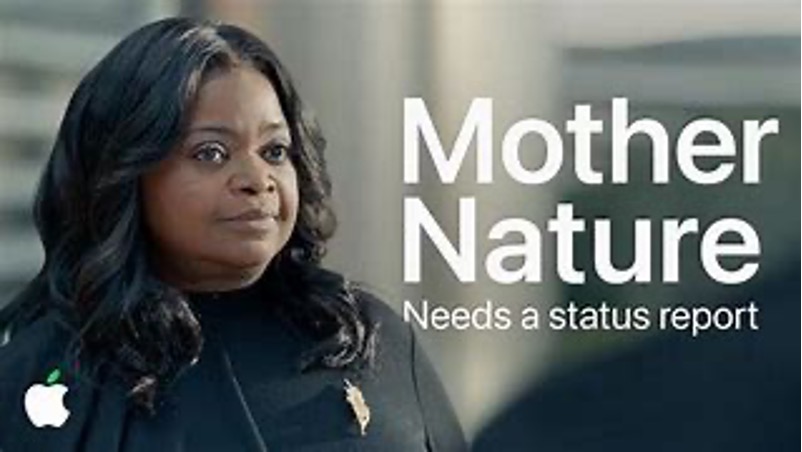
Corporate sustainability communication is becoming more sophisticated. This does not imply that such communication has become more truthful or more efficient in attaining its goals. What it means is that corporate communicators have become more aware of the dynamics at play when publicly announcing their sustainability ideals and aspirations. Taking a point of departure in a recent campaign from Apple, this blog post provides a glimpse into the strategic concerns, hopes and practices of contemporary corporate communicators. Understanding these concerns, hopes and practices can help us appreciate how communication and sustainability practices are related.
In a new mockumentary video called “2030 Status | Mother Nature” Apple simulates a status meeting between its sustainability staff and Mother Nature, played by Octavia Spencer. In the meeting, in which CEO Tim Cook participates, Mother Nature asks tough questions ostensibly formulated to seriously challenge Apple’s existing sustainability goals and accomplishments. Her opening statement sets the scene: “This is my third corporate responsibility gig today, so who wants to disappoint me first?”. Everyone present, except Mother Nature, is very nervous, eager to convince her that the company’s efforts and aspirations in the sustainability arena are sincere and significant. A dry home plant, for example, is moved out of sight and a leather jacket on a staff member is acknowledged as an imperfection in a company that plans to phase out leather. Mother Nature retains a skeptical attitude throughout, although she lightens up a bit when presented with what the company calls “carbon free products”. “I wanna see you do more of this”, she says, to which Tim Cook replies “You will!”. Towards the end of the video a staring contest between Mother Nature and the CEO follows his repeated proclamation that the company will live up to its 2030 ambitions. While leaving and announcing that she will be back next year, Mother Nature says “Don’t disappoint your mother!”
The video is obviously designed to convince a broader audience, including the company’s own employees, that Apple – as opposed to its competitors – is on the right track towards more sustainable products and practices. At the same time, however, it reflects a number of more generic corporate insights, hopes and concerns when it comes to sustainability and social responsibility. Firstly, corporations like Apple know that their audiences are sophisticated and not easily manipulated. Secondly, they are aware that no matter what they communicate about sustainability, they are likely to be criticized and perhaps called out as hypocrites. Thirdly, they realize that critics will focus especially on gaps between corporate sustainability talk and corporate action. Despite the risks of announcing sustainability ambitions under these conditions, they recognize that public mediation and exposure may be necessary, not only to build a particular brand identity, but to apply the necessary pressure on themselves.
Importantly, none of these insights and conditions imply that corporations such as Apple necessarily become more sustainable in their practices. In fact, a closer look at the video suggests that strategic sustainability communication is still primarily focused on impression management. The nervous staff signals that the company takes it audience very seriously. The presented flaws, such as the dry home plant and the misplaced leather jacket, are included to give the impression that the company is aware that it is less than perfect. And while this confession may be obscuring more substantial imperfections, it simultaneously serves to generate sympathy for the company whose members are ordinary people like everybody else.
What is especially interesting in the video from a strategic communication perspective is the construction of a critical other, embodied by Mother Nature, whose questioning is meant to preempt the inquiries of the company’s most critical NGOs. “Let’s cut to the chase”, she says up front, calling for “materials” and “status” and emulating the sentiments of many critics, even those who may refrain from articulating their suspicions so clearly. Reminding the company of its promises and calling out sustainability clichés such as “carbon neutrality” and the planting of trees (“Everybody’s planting trees”), Mother Nature not only represents intelligent but absent critics. She simultaneously allows the company to feature its most remarkable accomplishments such as the planting of forests (as opposed to trees) several places in South America and Africa. Her critical and almost arrogant attitude, in other words, provides a perfect opportunity for the company to emphasize its claimed qualities and ambitions that allegedly set it apart from its competitors. Its ambition to “permanently remove carbon from the atmosphere”, for example, is staged towards the end of the video as a promise that significantly trumps all other sustainability ambitions.
What the video illustrates above all is the energy and efforts that contemporary corporations put into the preparation of the “show”, that is, the important meeting where their aspirations meet the critical public. Such efforts – and the Mother Nature video is a prime example – illustrate that corporations have become more realistic and adept in reading the concerns and sentiments of their stakeholders. Whether their updated communication practices, explicitly acknowledging and integrating those concerns and sentiments, will actually convince critical audiences is another matter. Corporations like Apple may hope to appear more authentic and sincere by portraying “real people” sweating nervously when confronted with an intelligent and critical audience. Yet, that very same audience can easily see through the effort and is unlikely to be significantly influenced by the message. The real receiver of the message is arguably the corporation itself, hoping that its employees fully understand the risks of communicating about sustainability and other sensitive issues of the day. Such organizational autocommunication, especially when it appears in external media, is important to raise collective awareness. Yet, by constructing themselves the image of the critical “public”, corporate senders may delude themselves to believe they have established a buffer against the real world. In doing so, however, they may end up losing touch with their surroundings.
Suggestion for further reading:
- Christensen, L. T. & Christensen, E. (2022). Preparing the show: Organizational ventriloquism as autocommunication. Organization Theory, 3, 1-21. https://doi.org/10.1177/26317877221098767

Lars Thøger Christensen is Professor of Communication and Organization at the Copenhagen Business School, Denmark. His research focuses on how organizations create realities for themselves and their surroundings through communicative practices.




